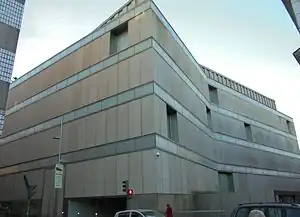Castelao Building
The Castelao building is a modern architectural building from the beginning of the 21st century located on the corner of Padre Amoedo Carballo and Sierra Street in Pontevedra, Spain, on the edge of the historic centre. It belongs to the Pontevedra Museum.
| Castelao Building | |
|---|---|
Edificio Castelao del Museo de Pontevedra | |
 North façade of the Castelao Building | |
| General information | |
| Type | Museum |
| Location | Pontevedra, Galicia, Spain |
| Coordinates | 42°26′01.3″N 8°38′31.8″W |
| Construction started | 2004 |
| Completed | 2008 |
| Opening | 4 January 2013 |
| Owner | Deputation of Pontevedra |
| Technical details | |
| Floor count | 4 |
| Floor area | 10,000 m2 |
| Design and construction | |
| Architect(s) | Jesús Ulargui and Eduardo Pesquera |
| Main contractor | ACS Group |
| Website | |
| www | |
History
On 2 May 2003, during the inauguration of the extension of the Fernández López building of the Museum of Pontevedra, its director announced that a new museum building would be built between Cobián Roffignac and Sierra streets.[1]
The building was built between 2004[2] and 2008[3] according to a project by the architects Eduardo Pesquera and Jesús Ulargui to overcome the Pontevedra Museum's lack of exhibition space.[4] It is located on the site of the former orchard of the Jesuit College in the city, behind the college and the church of Saint Bartholomew.[5]
The building was financed by the Deputation of Pontevedra, with the support of the Spanish Ministry of Culture, the Xunta de Galicia and the Pontevedra City Council. The project involved the creation of a new pedestrian street between Padre Amoedo and Arcos de San Bartolomé streets.[2]
The temporary exhibition space was inaugurated in July 2008 with the Art Biennial dedicated to the Maghreb.[6] After the implementation of the museography, the building was inaugurated on 4 January 2013.[7] On 2 December 2021, it was named the Castelao Building, in honour of Alfonso Daniel Rodríguez Castelao, one of the founders of the Pontevedra Museum.,[8][9]
Description
The building covers an area of 10,000 square metres and consists of three floors and a ground floor. It has 23 permanent exhibition rooms, with mostly pictorial works, which show the evolution of Galician art from the Gothic period to the present day, as well as artistic manifestations from other regions of Spain from the time of Goya to the mid-20th century.[10] Three of the rooms are dedicated to Castelao and there is also ample space for the rich collection of Spanish painting by painters such as Goya, Fortuny, Rusiñol and Vázquez Díaz, and for Galician art with a broad representation of renovators such as Maside, Torres, Souto, Colmeiro and Laxeiro.[11]
The building also has temporary exhibition rooms, an auditorium, a cafeteria and workshop spaces. In addition, on its underground floor, a 50-metre section of the remains of the ancient walls of Pontevedra can be seen, integrated into the building.,[5][12]
The most remarkable feature of the building is its brightness. It is built around two rectangular structures connected by glass walkways. The interior combines white concrete in the structure with granite floors and bleached wood floors in the rooms. The smaller southern module is glazed[13] to give it lightness and to facilitate the transition to the museum's Sarmiento building, to which it is connected by two glass walkways at mid-height. The northern structure, which is more imposing and airtight, has granite exterior walls and longitudinal glass security panels that allow natural light to enter from the upper part of the rooms and function as zenithal windows.[14]
Gallery
.jpg.webp) Interior
Interior Entrance to the building
Entrance to the building.jpg.webp) Corridor inside
Corridor inside Remains of the ramparts
Remains of the ramparts Main facade
Main facade.jpg.webp) Interior glass walkways
Interior glass walkways.jpg.webp) Pedestrian street
Pedestrian street.jpg.webp) Second floor
Second floor.jpg.webp) Glass building
Glass building.jpg.webp) Second floor
Second floor
References
- "El Museo de Pontevedra se convierte en uno de los grandes de España". La Voz de Galicia (in Spanish). 2 May 2003.
- "Florentino Pérez dice que hará la obra del Museo como si fuese el Prado". La Voz de Galicia (in Spanish). 14 February 2004.
- "Rajoy inaugura un edificio del Museo de Pontevedra construido en 2008". El País (in Spanish). 4 January 2013.
- "Comiendo a salto de barra". El País (in Spanish). 13 June 2014.
- "Visita los seis edificios del Museo de Pontevedra". La Voz de Galicia (in Spanish). 26 November 2018.
- "Rajoy inaugura las 23 salas permanentes del sexto edificio del Museo Provincial". Faro (in Spanish). 4 January 2013.
- "Rajoy reivindica el Museo de Pontevedra como el mejor provincial de España". La Voz de Galicia (in Spanish). 4 January 2013.
- "El Sexto Edificio del Museo pasa a denominarse Edificio Castelao". La Voz de Galicia (in Spanish). 14 January 2021.
- "El Museo ya presume de Castelao con su nombre en la fachada". Pontevedra Viva (in Spanish). 2 December 2021.
- "48 horas en Pontevedra: la bella desconocida". ABC (in Spanish). 17 July 2013.
- "El nuevo Museo de Pontevedra viaja a la Bienal de Venecia". La Voz de Galicia (in Spanish). 10 September 2008.
- "Luz verde para recuperar el tramo más largo de la muralla". La Voz de Galicia (in Spanish). 20 June 2008.
- "Edificio nuevo sin palmera centenaria". La Voz de Galicia (in Spanish). 12 October 2017.
- "El nuevo Museo de Pontevedra llega a Venecia". El País (in Spanish). 10 September 2008.
See also
Bibliography
- Aganzo, Carlos (2010). Pontevedra. Ciudades con encanto (in Spanish). Madrid: El País-Aguilar. p. 52. ISBN 978-8403509344.
- Riveiro Tobío, Elvira (2008). Descubrir Pontevedra (in Spanish). Pontevedra: Edicións do Cumio. p. 63. ISBN 9788482890852.
- Varela Campos, María de la Paz (2009). Guía de museos de Galicia (in Spanish). Pontevedra: Edicións Nigra Trea. pp. 99–101. ISBN 978-8495364074.